

| OTHER
CITIES IN THIS SERIES INCLUDE |
|||||||||
|
Castile and León are not at the top of most English visitors' lists of destinations in Spain but those who ignore the region are missing some wonderful historic cities and dramatic scenery as they head instead for the sunshine tourist-traps of the Iberian "Costas". The former kingdoms of Castilla (Old Castile) and León now constitute an Autonomous Community which, covering an area of 94,223 km², is the largest such region in Spain. Despite its size, its population is less than three million. It comprises nine Provinces, eight of whose provincial capitals are covered below - the information given is based on visits made in June 2007. The ninth capital, which was not visited, is the most easterly, Soria.
All of the cities mentioned below can be easily reached for a day-trip either by rail or by coach from Valladolid.
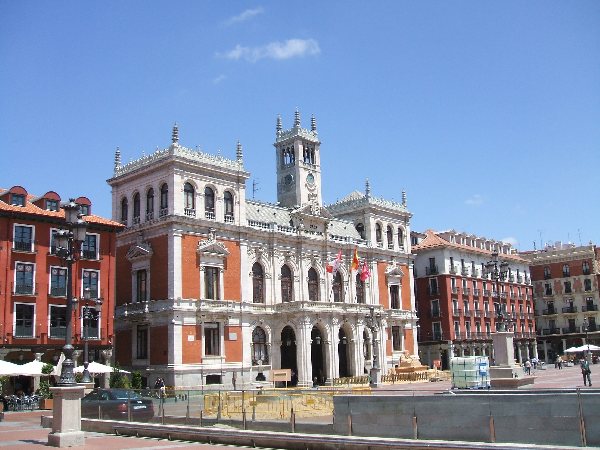
Right: Valladolid's Plaza Mayor
An excellent base for visiting Castile and León is the city of Valladolid, the one-time capital of Spain and the birthplace of King Philip II. Located 162km (100 miles) NW of today's capital, Madrid, Valladolid is a much under-rated place by most tourist guides. Not only is it centrally located for day visits to all eight of the other provincial capitals of the Region, it is an attractive city in itself, with a mixture of modern and traditional facilities. The largest shop on its attractive main square (Plaza Mayor), for example, is a wonderful ironmongers, founded in 1832, which stocks everything from coffee grinders and banana slicers to screwdrivers and hunting knives.
You can get there from Britain by air, direct from London Stansted by Ryanair in two hours. The airport is fairly close (10km) to the city at Villanubla and is very quiet so you are unlikely to be delayed by lengthy queues at security checks. Once inside the terminal, there is a bus-ticket counter in the main hall where you can book on the more or less hourly service operated by Linecar coaches to the city centre. In 2007 it cost three Euros single, with the end of the journey being the modern main bus station in the south of the city. Services to all parts of Spain serve the coach station. The fare from the airport is 3 Euros (2007) compared with about 20 in a taxi. Alternatively you can book in advance on the Web to connect with one of Alsa's longer-distance buses to other destinations and it will hopefully divert to pick you up outside the terminal.
Once in Valladolid, there is a taxi rank at the city coach station should you need onward transport. Otherwise it is a very pleasant 10-15 walk through the shady Campo Grande park to the Plaza Zorrilla, the second focal point of the city after the Plaza Mayor, which lies a five-minute walk further on up the Calle Santiago. The main railway station, Valladolid Campo Grande, is a five minute walk to the east of the bus station. The railway track at the station is currently (2007) undergoing major work as the new rail line to European gauge is being driven north from Madrid.
The Valladolid town council produces an excellent series of brief guided walks round the city which are available from its Turismo offices - one of which is conveniently sited near the fountain at the Plaza Zorrilla on the Acera de Recoletos. The city also has the Casa Cervantes (Calle del Rastro), where the famous writer once lived and as Columbus died in the city, it also has a Museo Colón (Calle Colón) though this is a modernistic exhibition centre rather than a collection of artefacts.
In the city itself there are plenty of attractive buildings and the Plaza Zorrilla is a focal point with its impressive fountain and backdrop of the Academia de Caballeria (Cavalry Academy). The Museo Nacional de Escultura (National Museum of Sculpture) has an excellent collection of predominantly ecclesiastical sculpture and the sculptured doorway of the Colegio de San Gregorio, opposite the museum entrance, is superb. A newer attraction in the city is the Museo Patio Herreriano, in a converted monastery, which is dedicated to modern Spanish art, whilst also worth a visit is the Museo Oriental, which houses art from China and the East Indies.
Good and reasonably priced restaurants in the city (near the Plaza Mayor) include La Cueva (Calle Correos 4) and, opposite, La Balconada (Calle Correos 3). Local specialities include roast suckling pig. For good tapas, try the nearby Taberna del Herrero.
Amongst the historic cities and provincial capitals of Castile and León that can easily be reached in a day-return trip from Valladolid are Burgos (125km), Leon (139km), Salamanca (115km), Segovia (92km), Avila (120km), Palencia (47km), Zamora (87km).
Coach travel is similar. Although companies such as AutoRes will issue you a conventional return ticket with a stated return time and seat number, most other companies, though also computerised, will issue you a return ticket which requires you to "formalizar" your return journey. In other words you have to go to the company's ticket office on arrival at your destination, tell them which service you want to come back on and get issued with a new ticket for that journey. Again the price may vary as some coaches are "all stops" and others are expresses. All in all, the ticketing is very cumbersome and in some cases time-consuming but that is the way it is!
Some coach routes appear to be direct but the coach will actually divert off the road to some small villages to pick up one or two people - or in some cases your diversion will yield no waiting passengers at all! On the way to León by La Regional, for example, you may stop 8 or 9 times each way! It all adds to the experience of your holiday as you see places you would never otherwise have visited.
The main bus companies from Valladolid all use the main bus station (Calle Puente Colgante), which is modern and well organised but at which you won't find a single leaflet or central timetable display. There is a central display board showing the next few departures but, for planning a journey you need to go to each company's booking office in the bus station and check their destinations and their timetables which, in some cases, are posted on their booking windows and in others are not! The main companies include AutoRes, Alsa, La Regional and Linecar. There are regular services to Madrid as well as to the nearby provinces and also some international vehicles - one service even runs from Valladolid to Bulgaria!
Virtually all the coaches are modern and air conditioned and the driving is generally very sensible. All coaches have luggage holds where you are expected to put large bags but small bags can be taken on board though there are often no luggage racks.
The numerous destinations available by public transport for a day-return trip include Burgos, León, Segovia, Avila, Zamora, Palencia and Salamanca. Some places are better served by train than others, whilst others are better reached by coach. As with coaches, rail route timings and arrival times are hard to find; the station has no list of services arranged by destination and printed timetable leaflets are only erratically available. So, you may be reduced to working through the chronologically listed departures and arrivals, to see if the destination you want is listed as one of the stops.
|
This historic University town can be reached by AutoRes services from Valladolid. The bus station is on the Avenida Filiberto Villalobos and if you head to the right out of the front of the bus station it is a 10-15 minute walk through initially unexceptional streets till you hit the historic centre and the impressive Plaza Mayor, which is ringed by cafés including the Cafetaría Berysa. The main tourist office is also in this square.. The other main sites include the Catedral (in fact, this is two buildings - an Old and a New cathedral) and the Universidad. Climbing the Ieronimus tower (Torre Mocha) is worth it for the excellent views over the city and of the cathedral roof. Also worth visiting is the Clerecía baroque church and the nearby Casa de las Conchas, a 16th-century building incorporating carved shells; the shell is the symbol of the pilgrims to Santiago, who pass through this way on their way to Santiago de Compostela. Behind the Cathedral, overlooking the river Tormes is the Museo Art Nouveau housed in the striking Casa Lis. The AutoRes coach fare from Valladolid to Salamanca (2007) varies from 6.45 Euros upwards depending on the level of service.
Right: Salamanca cathedral
|
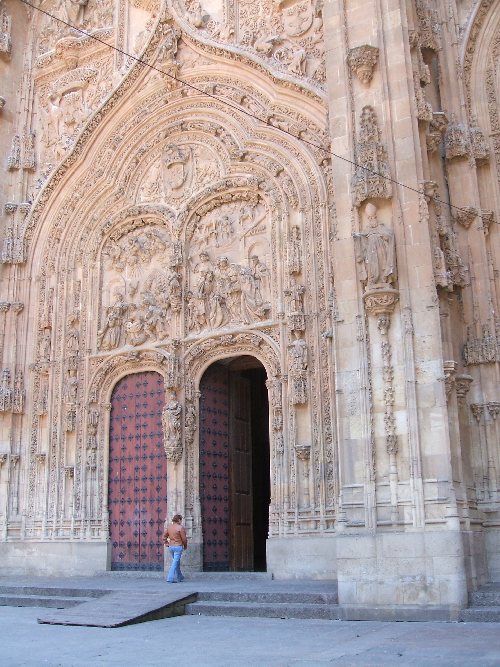
|
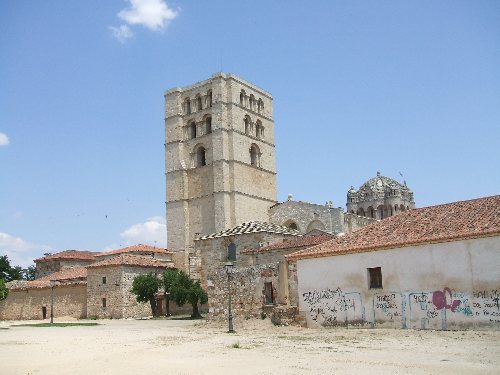
|
|
A much quieter and smaller town than Salamanca is
Zamora, renowned for witholding a medieval siege and
still containing many historic buildings. The bus
station is a good 20 minutes walk from the centre along
the Avenida Tres Cruces - you will see the three small
crosses of its name at the start of street which on the
far side of the avenue outside the bus station. Though
only 50km from the border with portugal, transport to
Portugal is poor. The Plaza Mayor is attractive with the
church of San Juan and it has several cafés. The café
facing the church serves excellent hot bacon sandwiches
and has a good view of the square. The Cathedral is
located near to the remains of the citadel at the far
end of the main street (Notarios).
Left: Zamora cathedral
|
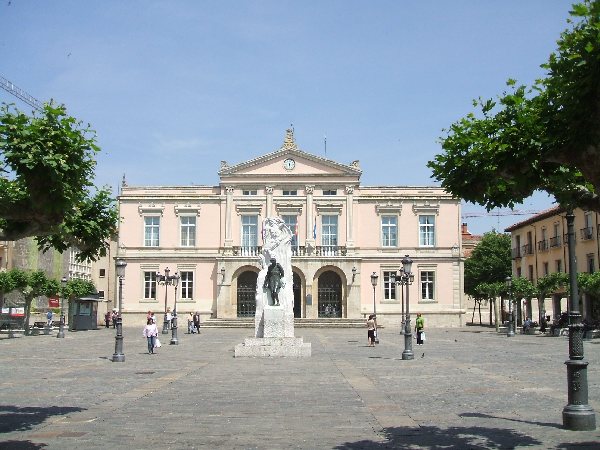
Right: Palencia's Plaza Mayor.
This city, like Soria, is not as firmly on the tourist track as the other capitals of Castile and Leon's provinces. But it is unjustly termed an "unattractive capital city" by the Rough Guide. In reality, it is well worth a visit if only for its impressive cathedral, the long, arcaded shopping street, the excellent and compact Museo de Palencia (archaeological museum) and the very pleasant Plaza Mayor which has an agreeable small-town atmosphere compared with the tourist-thronged equivalents in the likes of Salamanca and Segovia. The railway station is situated a couple of minutes walk from the northern end of the main street, the Calle Mayor. The station platforms, like most in Spain, are watched over by a private security firm and having taken an innocent picture of a train, I was required to erase it from my camera in the interests of "security" (2007). The return rail fare from Valladolid is just 5.50 Euros (2007)
Just outside the station, mounted incongruously on a plinth is an agricultural, (rather than railway), steam-engine, much in need of a coat of paint (2007). But if you walk through the pleasant gardens you will find a wooden hut which is a city information office from where a free city map can be obtained. With the station behind you, the main street (Calle Mayor) is to the left at the roundabout (Plaza de León). The Calle Mayor is well over a mile long and most of it is very pleasantly arcaded. The Plaza Mayor lies off this street, to the left. At the bottom end of the square, opposite the civic hall are several pleasant cafés and restaurants. A good place to eat in the Plaza Mayor (no.14) is the Café/Restaurante La Trebede Adjacent to the square is the local market whilst the 14th/15th century cathedral is located off to the right of the Calle Mayor towards the river Carrión. After visiting the cathedral, with your back to the main door of the cathedral, the unprepossessing narrow street in the right-hand corner of the square, which runs away from the cathedral, leads after a couple of minutes to the Museo de Palencia in the Palacio Cordón, so named because of the impressive stone sculptures of ropes around its door. Inside this historic building there is a very modern three-floor-series of small galleries displaying the archaeological heritage of Palencia. There is also as 15 minute audio-visual presentation, which provides interesting information, though only in Spanish. From the museum, carry on for a few hundred yards and you will come to the ancient bridge (Puente Mayor) over the river.
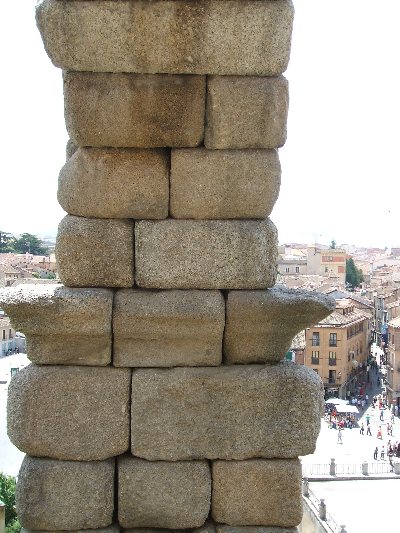 |
One of the more tourist-orientated capitals in
Castile and León is Segovia, both because it is nearer
to Madrid than most and because it has the world-famous
Roman aqueduct at its heart, dating from the first
century AD. The aqueduct is some 800 metres long and is
30 metres above street level at its highest point. The
tourist information centre is at the bottom of this
highest stretch in the Plaza de Azoguejo. It is thought
to date from the end of the first century A.D.
Elsewhere, the busy main square (Plaza Mayor) has plenty
of cafés and restaurants and the nearby cathedral (3
Euros in 2007) is well worth a visit. The Cathedral was
started in 1525 by Charles the Fifth.
In the Plaza Mayor the Mesón Mayor is one restaurant that provides good food and service. But more impressive than the Plaza and the cathedral is the Alcázar (castle) which lies about 10 minutes away (entry €4 in 2007). The views from the large windows are impressive and inside there are some impressive rooms. Much of what you see now is post 1862 as a major fire struck the building in that year. In 1474 Isabella la Católica was proclaimed Queen of Castile and crowned in the Iglesia San Miguel.. The coach fare from Valladolid to Segovia in 2007 was 12.05 Euros.
Left: Segovia's Roman aqueduct has no mortar holding it together.
|
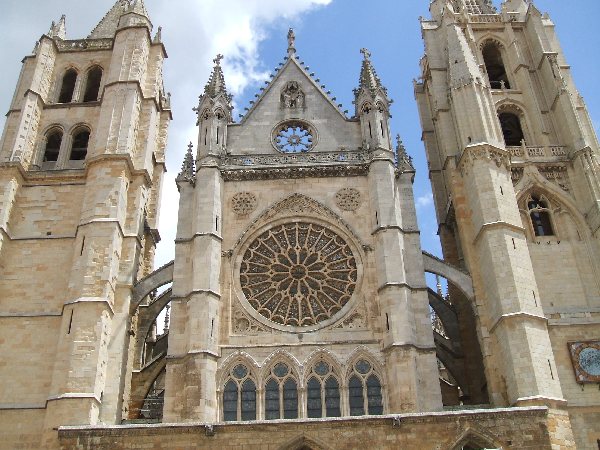
Above: León cathedral.
The approach to the city is uninspiring but the city is well worth the visit. The bus station at León has a superb restaurant with excellent service and food, it is called the Parada de Postas. In 2007 its 10 Euro menu was a bargain. The Alsa coach fare in 2007 was 7.42 Euros. The walk across the river Bernesga from the bus or rail station leads you into the centre, passing Gaudi's wonderful Casa de Botines building on the left. The cathedral is remarkable both from the exterior and the inside, where its stained glass is exceptional.
| Avila is Spain's highest provincial capital. Its main
square is in front of the church but a more pleasant
space is the Plaza del Chico Mercado, which has a few
cafes including El Portalón at number 4 (in the top left
corner) which serves superb hot pork sandwiches. The
train fare from Valladolid was 12.15 Euros in 2007 but
it will be higher on better trains. The Cathedral is
worth a visit but you can see little of its interior
unless you also pay to visit the museum and cloisters -
which is worth the expense (4 Euros). The walls are also
worth the entrance fee as they afford excellent views of
the city and its environs.
Right: Avila's impressive city walls attract the swallows.
|
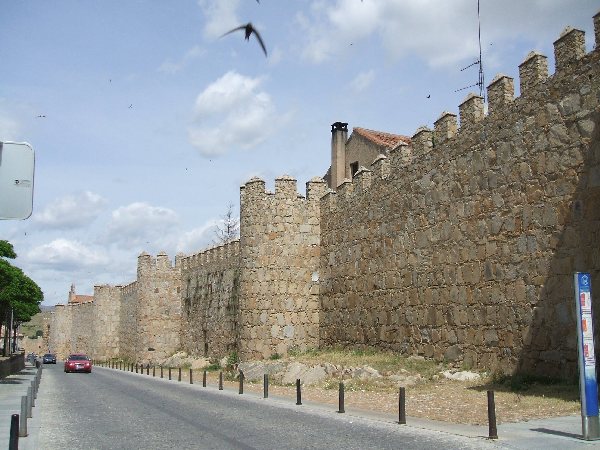
|
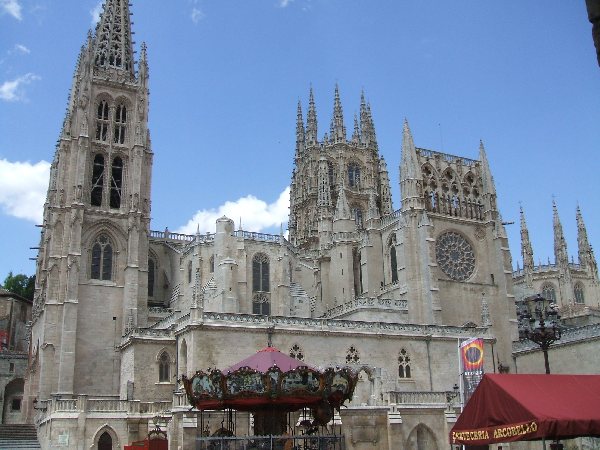 |
From the railway station walk forward across the bridge over the River Arlanzón and bear right to the city centre. The bus station is slightly nearer the centre but again you need to cross the river and aim for the cathedral towers. A visit to the cathedral is a must- it is a World Heritage site- and the accolade is well merited. It contains the tomb of El Cid and his wife as well as numerous impressive carvings and chapels. You can enjoy a wide range of fixed-price and excellent menus at the Restaurante Bonfín in the Calle Cadena y Eleta, 1, which faces the side of the Cathedral. The city gate near the cathedral, Arco de Santa María, is very impressive and you can admire it from a seat outside the adjacent Fox Tavern (Paseo del Espolón 4). It is also worth the ten minute walk to the Seminario Mayor San Jerónimo, near which is another city gate, the Arco de San Martín. The return rail fare from Valladolid was 13.30 Euros (2007).
Left: Burgos cathedral
|
Copyright 1999-: ©![]()
Contact: the following is not a link; please transcribe the address into your email 